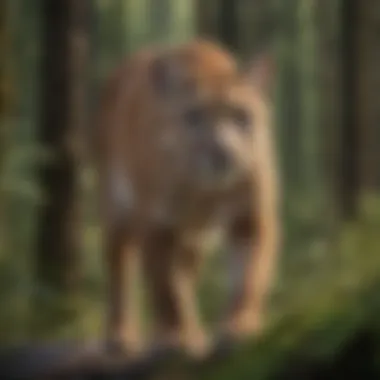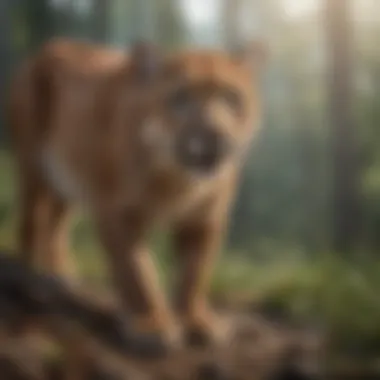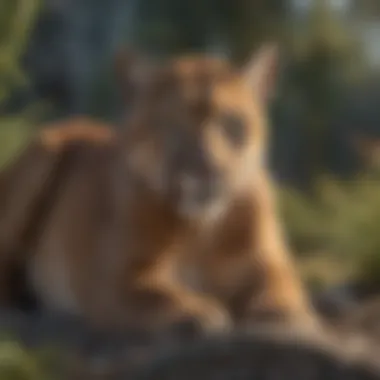Unraveling the Enigmatic North American Puma: A Comprehensive Investigation


Nature Topic Overview
The North American Puma, also known as the mountain lion or cougar, is a fascinating creature that roams the wilderness with a majestic presence. Its elusive nature and predatory skills make it a key player in the ecosystem, showcasing the intricate balance of nature in the North American wilderness.
Fun Facts and Trivia
For young readers curious about the North American Puma, here are some engaging facts to pique their interest. Did you know that pumas can leap up to 5.5 meters in distance in one go? These powerful big cats have an incredible sense of sight and can see clearly in low light conditions, making them stealthy hunters in the darkness of night.
Wildlife Explorations
The North American Puma shares its habitat with various fascinating species, such as the elusive gray wolf and the graceful mule deer. Exploring the interconnected web of wildlife in the puma's environment unveils a rich tapestry of nature's diversity. Interactive quizzes and puzzles can challenge young minds to learn more about these incredible creatures.
Environmental Awareness
Understanding the importance of conserving the habitat of the North American Puma is crucial for maintaining the balance of the ecosystem. Children can play a vital role in protecting these majestic big cats by learning about conservation efforts and adopting sustainable practices. Tips on how they can contribute to safeguarding nature provide a practical approach to environmental awareness.
DIY Nature Activities
Encourage young nature enthusiasts to engage in hands-on activities that connect them with the wild world of the puma. Creating nature-inspired crafts, setting up bird feeders, or embarking on outdoor explorations to observe wildlife in their natural habitat not only educates but instills a deeper appreciation for the mysteries of nature.
Introduction
The grandiose world of the North American Puma beckons us into a realm of mystery and majesty, where the elusive mountain lion reigns supreme as a symbol of untamed wilderness. In this in-depth exploration, we unravel the intricacies of this solitary and alluring feline predator that roams the vast expanse of North America. The reverberations of its existence echo through the vast landscapes, leaving imprints of both fascination and fear among those who dare to delve into its enigmatic existence.
As we embark on this journey of discovery, we will uncover the significance of the North American Puma, also known as the mountain lion or cougar, in the intricate web of life that sustains ecosystems across the continent. By scrutinizing its habitat, behavior, and ecological contributions, we unveil a tapestry of connections that underline the indispensable role this magnificent big cat plays in maintaining the delicate balance of nature.
Our expedition into the world of the North American Puma goes beyond a mere observation of a wild creature; it evolves into a profound exploration of our relationship with the natural world. Through this lens, we witness the resilience of a species that embodies the essence of survival in the face of ever-encroaching human influence and environmental changes.
Join us as we traverse the realms of the North American Puma, peeling back the layers of ambiguity to reveal a creature that captivates our imagination and embodies the spirit of unyielding strength and adaptability. Let us delve deeper into the world of this celebrated predator, witnessing its grace, power, and significance in shaping the ecosystems it inhabits.


Taxonomy and Nomenclature
In the realm of the North American Puma, understanding taxonomy and nomenclature is paramount. Taxonomy, the science of classifying organisms, and nomenclature, the assignment of names to these organisms, play a crucial role in distinguishing and categorizing the different species within the animal kingdom. For the North American Puma, delving into its taxonomy reveals insights into its evolutionary history, genetic makeup, and relationships with other species. Nomenclature, on the other hand, provides us with the various names by which the North American Puma is known, such as mountain lion or cougar. These names not only hold cultural significance but also aid researchers, conservationists, and enthusiasts in communicating about this magnificent big cat effectively.
Genus and Species
The North American Puma belongs to the genus Puma and the species Puma concolor. Within the animal kingdom, the classification at the genus level groups similar species together based on shared characteristics. In the case of the North American Puma, being part of the genus Puma highlights its close relation to other puma species found in different regions of the world. At the species level, Puma concolor specifically identifies the North American Puma, emphasizing its unique genetic and physical attributes that differentiate it from other species within the genus Puma.
Common Names
Aside from its scientific classifications, the North American Puma goes by several common names, reflecting its widespread presence and cultural significance. Known as the mountain lion in regions with mountainous terrain and as the cougar in various parts of North America, these common names enrich our understanding of how different populations perceive and interact with this elusive big cat. The choice of common names also reflects the ecological habitats in which the North American Puma thrives, showcasing the adaptability and resilience of this apex predator in diverse environments.
Physical Characteristics
The section on Physical Characteristics delves into the intricate details that define the North American Puma, shedding light on its essential features that set it apart in the wild. Understanding the physical traits of this elusive feline is crucial to appreciating its adaptability and survival strategies. Through a meticulous examination of its size, weight, coat, and coloration, readers can unravel the secrets behind this magnificent creature's camouflage and agility.
Size and Weight
When it comes to the size and weight of the North American Puma, meticulous measurements reveal a creature of remarkable proportions. Adult Pumas typically weigh between 60 to 220 pounds, with males being larger and heavier than females. Their bodies can stretch up to 7 to 9 feet in length, including their tails, making them one of the largest wild cats in North America. This formidable size empowers them as dominant predators in their habitat, capable of taking down prey much larger than themselves. Their muscular build and agile movements showcase their prowess in the art of hunting, ensuring their survival in the competitive realm of the animal kingdom.
Coat and Coloration
The coat and coloration of the North American Puma play a pivotal role in its survival within various habitats, ranging from dense forests to arid plains. Their sleek coats come in shades of tan, gray, or reddish-brown, providing effective camouflage in different environments. The subtle patterns on their fur help them blend seamlessly into their surroundings, aiding in stalking prey and avoiding detection by potential threats. Additionally, the Puma's thick coat offers insulation against harsh weather conditions, allowing them to thrive in diverse climates across their vast range. Understanding the nuances of their coat and coloration provides insight into how these majestic felines have mastered the art of adaptation and stealth in the wilderness.
Habitat and Range
Biomes
When exploring the North American Puma's habitat, it is imperative to delve into the various biomes that these big cats inhabit. Biomes play a significant role in shaping the environment where pumas reside, influencing their hunting patterns, territorial behavior, and interactions with other species. From dense forests to rugged mountain terrains, each biome presents unique challenges and opportunities for these apex predators, highlighting the adaptability and resilience of the North American Puma.


Geographical Distribution
The geographical distribution of the North American Puma is a critical aspect that sheds light on the vast territories these big cats traverse. Understanding their geographical range provides crucial data on their migration patterns, population density, and potential conservation strategies. From the rugged landscapes of the Rocky Mountains to the sprawling forests of the Pacific Northwest, the geographical distribution of the North American Puma underscores the diverse ecosystems they call home.
Behavior and Diet
Hunting Techniques
A fundamental aspect of the North American Puma's behavior is its hunting techniques. Pumas exhibit remarkable stealth and agility while stalking their prey. Their hunting prowess lies in their ability to ambush prey with a blend of speed and precision. By understanding the puma's hunting techniques, readers can grasp the strategic acumen these big cats employ to secure their next meal. From patiently observing to swift chases, the hunting tactics of the puma are a mesmerizing display of predatory skills that have evolved over generations.
Prey Selection
The Prey Selection segment delves into the dietary preferences of the North American Puma. The meticulous choice of prey by these big cats is intertwined with their ecological role as apex predators. By exploring the puma's prey selection criteria, ranging from size to behavior of the target animals, readers can comprehend the delicate balance that exists in predator-prey relationships. The adaptability of pumas in selecting diverse prey species reflects their adaptiveness to varying environmental conditions and availability of resources. Delving into the nuances of prey selection offers a glimpse into the ecological dynamics governed by the North American Puma.
Reproduction and Family Structure
Mating Behavior
Mating behavior is a crucial aspect of the North American Puma's life cycle, influencing not only population dynamics but also genetic diversity. Pumas exhibit intriguing courtship rituals, mate selection criteria, and mating strategies that contribute to the survival of their species. Exploring the nuances of puma mating behavior provides insights into their social dynamics, reproductive success, and conservation needs.
Cubs and Parental Care
The care and nurturing of puma cubs by their parents are paramount for the survival and development of the young within this elusive species. Cubs rely heavily on their mothers for nourishment, protection, and essential life skills. Examining the intricacies of parental care among North American Pumas sheds light on the challenges faced by these endangered big cats and the critical role parental involvement plays in shaping their future survival and ecological impact.
Ecological Role
The Ecological Role of the North American Puma is a crucial aspect of understanding the intricate balance of ecosystems where this majestic big cat resides. As a top predator, the Puma plays a vital role in regulating prey populations, which in turn helps maintain the overall health of the ecosystem. By preying on herbivores such as deer, the Puma helps control their numbers, preventing overgrazing that can lead to habitat degradation. This sophisticated predator-prey relationship is a fundamental component of a functioning ecosystem.
Top Predator Status


Within the ecosystem, the North American Puma holds the esteemed position of a top predator. This means that it has minimal natural predators and plays a vital role in keeping the populations of herbivores in check. The Puma's predatory prowess and ability to hunt efficiently contribute to the regulation of species below it on the food chain. Its status as a top predator showcases the importance of apex predators in maintaining the delicate balance of a healthy ecosystem.
Impact on Ecosystem
The Impact of the North American Puma on the Ecosystem is profound and far-reaching. By controlling the populations of herbivores, the Puma indirectly influences plant communities and the overall landscape. Through selective predation, the Puma can shape the distribution of prey species, leading to cascading effects on vegetation and other wildlife. Furthermore, the presence of Pumas can alter the behavior of prey animals, causing them to avoid certain areas, thus influencing plant growth patterns. Understanding the intricate web of interactions that the Puma has within its ecosystem is essential for conservation efforts and preserving the biodiversity of North American habitats.
Conservation Status
The conservation status of the North American Puma holds paramount significance in understanding and safeguarding this magnificent feline species. With a population once threatened by indiscriminate hunting and habitat destruction, the conservation status now serves as a critical barometer of the puma's survival. Documenting the conservation status involves meticulous surveys, data collection, and analysis to ascertain population trends and distribution. This information aids conservationists in formulating targeted strategies to protect and conserve these elusive predators.
Threats and Challenges
The North American Puma faces a multitude of threats and challenges that jeopardize its existence in the wild. Habitat loss due to urbanization and deforestation encroaches on puma territories, leading to fragmented populations and reduced genetic diversity. Human-wildlife conflicts pose a significant risk, with pumas often targeted due to perceived threats to livestock or human safety. Climate change further exacerbates these challenges by altering prey abundance and availability, forcing pumas to adapt to changing environments for survival.
Conservation Efforts
To mitigate the growing threats faced by the North American Puma, concerted conservation efforts are underway across its range. Conservation organizations collaborate with local communities, policymakers, and researchers to implement conservation programs aimed at protecting puma habitats and minimizing human-wildlife conflicts. Monitoring puma populations through camera traps, GPS collaring, and genetic analysis provides crucial data for conservation decision-making. Public awareness campaigns educate communities on coexisting with pumas and the importance of their conservation, fostering a culture of respect and stewardship towards these elusive big cats.
Human Interactions
Human interactions with the elusive North American Puma, also known as the mountain lion or cougar, hold profound significance in understanding the dynamic relationship between these magnificent predators and human populations. As civilization expands into puma habitats, encounters between humans and these big cats become more frequent, leading to both challenges and opportunities. By delving into the historical significance, conflicts, and potential solutions surrounding these interactions, we gain invaluable insights into coexisting harmoniously with these apex predators.
Historical Significance
The historical significance of human interactions with the North American Puma dates back centuries, intertwining with indigenous cultures, folklore, and colonial histories. Native American tribes revered the puma as a symbol of power, courage, and spiritual significance, often featuring prominently in their myths and legends. European settlers, upon arriving in the continent, viewed pumas as threats to livestock and safety, leading to widespread persecution of these elusive cats. By exploring the historical context of human-puma interactions, we unravel the intricate tapestry of attitudes and beliefs that shape contemporary perceptions of these apex predators.
Conflicts and Solutions
While human-puma conflicts pose challenges for both parties, innovative solutions can help mitigate these tensions and foster peaceful coexistence. Conflicts often arise due to puma predation on livestock, resulting in economic losses for ranchers and retaliatory killings of pumas. To address these conflicts, collaborative efforts between wildlife experts, conservationists, and local communities have implemented non-lethal deterrents, such as electric fencing and livestock guard animals, to protect both livestock and pumas. By promoting education and awareness about puma behavior and ecology, communities can develop strategies to prevent conflicts and safeguard these iconic predators for future generations.
Future Prospects
When considering the future prospects of the North American Puma, or mountain lion, it is vital to delve into the various factors that impact its survival and conservation efforts. As human populations expand, encroachment into puma habitats becomes more pronounced, leading to increased instances of human-puma conflicts. One of the key elements to focus on regarding the future of these magnificent predators is the development and implementation of effective conservation strategies that prioritize both human needs and the preservation of puma populations.
Future prospects for the North American Puma also necessitate a deeper understanding of the role these apex predators play in maintaining ecological balance. As top predators, pumas help regulate prey populations, preventing overgrazing and promoting overall ecosystem health. Therefore, safeguarding the future of pumas translates to safeguarding the overall integrity of the ecosystems they inhabit.
Moreover, the future of North American Pumas is intertwined with ongoing research and innovation in conservation biology. Scientific advancements in tracking technologies, genetic studies, and habitat restoration techniques hold promise in bolstering puma populations and mitigating threats to their existence. By staying abreast of these developments and actively supporting conservation initiatives, we can strive towards a future where these elusive felines continue to roam wild and free in their natural habitats, ensuring a harmonious coexistence between humans and wildlife.







